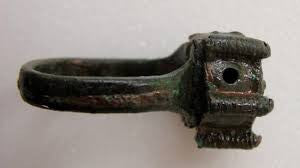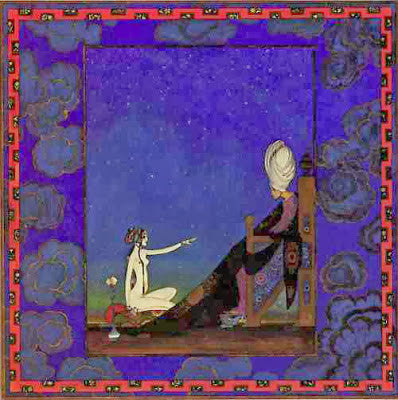Your Cart is Empty
Free Shipping for orders over $49 in Australia, $199 IN NEW ZEALAND/USA/CANADA AND $249 REST OF THE WORLD
Free Shipping for orders over $49 in Australia, $199 IN NEW ZEALAND/USA/CANADA AND $249 REST OF THE WORLD
Add description, images, menus and links to your mega menu
A column with no settings can be used as a spacer
Link to your collections, sales and even external links
Add up to five columns
Add description, images, menus and links to your mega menu
A column with no settings can be used as a spacer
Link to your collections, sales and even external links
Add up to five columns
The Poison Ring
by Linda Heaphy May 03, 2017
A poison ring (also called a locket, pillbox, casket, socket or box ring) is a type of ring with a container under the bezel or inside the bezel itself.
Poison rings, along with other types of lockets, are believed to have originated in Asia and date back at least to ancient Greek times. They replaced the practice of wearing keepsakes and other items in pouches or amulets around the neck and arm or at the belt. Used to carry items such as perfume, locks of hair, devotional relics, messages, pictures and keepsakes, locket rings were considered so useful that their custom rapidly spread to other parts of the world, reaching Western Europe in the Middle Ages. By then a huge demand existed for specialty caskets called reliquaries, created for the holy relic trade and used to house fragments of the physical remains of Christian saints and martyrs. Locket rings provided the perfect receptacles to keep such powerful items close-by.

Gold ring with concealed container. Swiss; undated, probably 16th or 17th century. Photo: Wellcome Images
The term poison ring became popular during the sixteenth century when it was commonly believed that locket rings were used by the aristocracy to facilitate the poisoning of the food or drink of an enemy, or even the suicide of a ring’s owner in order to escape capture or torture. Famously, Lucrezia Borgia was believed to favour the use of poison administered via locket rings, although these claims have never been substantiated. Her brother Cesare, it is true, owned a signet ring (still in existence) with a sliding panel, containing a small compartment, and he often boasted of using "the power of the Lion" on his enemies.
The wearing of rings containing painted miniatures was also popular at this time. During periods of religious (and therefore political) upheaval, for example during the reign of England’s Queen Mary and again during the time of the Restoration, locket rings were used to hide a wearer’s true political allegiance. In the 16th century, there was a craze for “funeral rings” shaped like miniature caskets, which served as mementos for mourners. This style of ring became popular again during the Victorian era, when rings and lockets containing portraits and locks of hair were worn to compliment lengthy mourning periods.

A locket ring belonging to Elizabeth I , taken from her finger on her death in 1603. Fashioned from mother of pearl, gold, pearls, rubies and diamonds, it was found to contain a secret compartment with two portraits; that of her mother,
Anne Boylen and herself.
No matter the romance of the idea, few actual documented deaths by use of poison ring exist. The death of Demosthenes, a Greek statesman and orator who spearheaded a revolt against Alexander the Great, is one example. As he was about to be arrested, Demosthenes is said to have committed suicide by way of a fast-acting poison hidden “in a hollow ring, which he wore by his arm”, a quote attributed to Plutarch. However in his Life of Demosthenes, Plutarch’s states that he took poison out of a pen reed, pretending he wanted to write a letter to his family. Hannibal is also said to have worn a poison ring and may have made use of it at his end; “he took poison, which, it was said, he had long carried about with him in a ring” (Cornelius Nepos, Hannibal 12.5; Juvenal, Satires X.164). CJS Thompson states in his Poison Romance and Poison Mysteries “Among the gems in the British Museum there is an onyx which has been hollowed out to form a receptacle for poison. The face of the stone is engraved with the head of a horned faun. To take the poison, it was only necessary to bite through the thin shell of the onyx and swallow the contents.” Thompson also states “When the gold deposited by Camillus (most likely he is referring to Furius Camillus, a Roman soldier and statesman) in the Capitol was taken away, it is recorded that the custodian responsible for it "broke the stone of his ring in his mouth," and died shortly afterwards”."

Bulgarian bronze poison ring, 14th Century.
In 2013 Bulgarian archaeologists unearthed a bronze ring that might have been used for political murders some 700 years ago. Found at the site of a former medieval fortress in Cape Kaliakra, the finely crafted ring was probably worn by a male on the little finger of the right hand and features a round, hollow cartridge decorated with granulation and an artificial hole. Dated to the 14th century, the poison ring is unique amongst all of the other jewellery found at the site. Bonnie Petrunova, head of the dig and deputy director of the National Archaeology Institute and Museum in Sofia stated “It’s a unique ring. I have no doubts that the hole is there on purpose and the ring was worn on the right hand, because the hole was made in such a way so as to be covered by a finger, thus the poison could be dropped at a moment’s notice. Clearly, it was not worn constantly and would have been put on when necessary”.
The historical certainty of poison rings aside, the tradition of storing and using poison via a ring is so beguiling that today any ring containing an opening compartment is called a poison ring, no matter its intended purpose.

“The Princess wore on her finger a ring, under the gem of which, in the contemplation of such a crisis, had long since been enclosed a deadly poison: and she no sooner ascertained the identity of Amru, than she swallowed the poison, ring and all, with a contemptuous smile, exclaiming, “I shall die by my own hand, never by thine!”” (Essay Towards the History of Arabia: Antecedent to the Birth of Mohommed By Major David Price, 1824). Photo credit: Kay Nielsen, Scheherazade Telling the Tales, de One Thousand and One Nights, 1918–22.

A casket or poison ring, sterling silver and lapis lazuli, Contemporary. For sale here. Photo credit: Kashgar
References and Further Reading
Evans, Susan.1998 The Ubiquitous Poison
Hesse, Rayner W 2007 Jewelrymaking Through History: An Encyclopedia. Greenwood Press, CT.
Huffington Post.Medieval Poison Ring Found in Bulgaria. Accessed 21st February 2015.
Lester, Katherine & Oerke, Bess Viola 2004 Accessories of Dress: An Illustrated Encyclopedia. Dover Publications, Mileola NY.
Thompson, CJS 1904 Poison Romance and Poison Mysteries. George Routledge & Sons, Ltd, London. Ebook format, accessed 20th January 2015.
Wikipedia. Poison Ring. Accessed 10th February 2015
Leave a comment
Comments will be approved before showing up.
Also in Jewellery & Stones

Pearl - Birthstone for June & Anniversary Gem for the Third and Thirtieth Wedding Anniversaries
by Linda Heaphy March 23, 2017
Read More Articles
About the Author
- Linda has a Honours degree in Marine Biology and a PhD in Ecology from the University of NSW, Australia. She has travelled extensively and is a passionate writer on subjects as diverse as the role played by women throughout history, tribal communities and their customs, symbology and ethnology, talismans and their history. Occasionally she also writes about her travel experiences, her new life on a 25 acres in the Northern Rivers region of northern Australia and her black miniature poodle Phoenix. She is currently writing her first book on talismans.
About Us
-
The Kashgar Philosophy

Kashgar began through a love of travel.
In 1989 my father Bernard packed in his house painting business and set off for two years on a backpacking trek to the remotest corners of the world. When he finally arrived in the oasis city of Kashgar, China, he was so impressed with its history that he decided to start a new life collecting and selling exotic goods from all over the world. For 2000 years the legendary city of Kashgar was a melting pot of ideas and a key trading post on the historic Silk Road. It was this unique combination of philosophy and trade that my father wanted to recreate at home.
Starting in markets in 1991, he opened his first store in the Sydney suburb of Newtown in 1994. I gave up my own career as a government scientist to join him in 2000 and soon convinced my partner Ian to join us in what was to become the Family Business.
Today our version of Kashgar stocks a hugely diverse range of furniture, rugs, textiles, antiques, handicrafts and jewellery sourced from over twenty different countries including India, Nepal, Tibet, China, Thailand, Burma, Laos, the Philippines, Vietnam, Mexico, Peru, Turkey, Palestine, Syria, Afghanistan and Turkmenistan. Our collection includes contemporary and tribal silver and gold jewellery, a unique range of headhunting curios, antique Buddhist relics and a collection of one-off necklaces, earrings and bracelets that I design and create myself using the beads and jewellery making techniques of ethnic minorities from around the globe.
Kashgar is a philosophy as well as a store. We are committed to supporting traditional artisans and small village communities by selling authentic handcrafted goods which are personally collected by us. By supporting traditional methods of design and production we hope to encourage local cottage industries which have a low impact on the environment and help ethnic minorities maintain their self-sufficiency into the 21st Century. We are particularly committed to assisting women around the world and to this end have worked with several organisations including the Hua Bin Women's Union of Vietnam, the East Timorese Women's Association and Tikondane in Zambia. Time honoured means of craftsmanship and traditional ways of life are disappearing as people all over the world give up their identity in favour of jeans and T-shirts. We see our trade as a means of staving off the inevitable encroachment of the 21st century, assisting communities to decide for themselves which parts of the western world they wish to incorporate (medicine, education) and which they wish to reject (prostitution, drug production, begging and servitude to warlords). We encourage our customers to think of the handicrafts and artifacts they buy from us as an investment: a piece of history and a way of life that may soon be gone forever.
Kashgar has recently closed its retail outlet and gone completely online.
In the past our pieces appeared in many movies including The Hobbit, Mission Impossible 2, Queen of the Damned, Scooby Doo, Moulin Rouge and Wolverine, and in many televisions series, as well as in plays, commercials and exhibitions. We've found special pieces for individual customers as well as for film sets, event management companies, hotels, businesses, consulates and embassies. The uniqueness of our stock means that we are also very appealing to interior and fashion designers with a taste for the exotic.
There is something for everyone at Kashgar - collectors, the curious, those looking for a special present or for something unique to adorn the home. Most of our items are one-off specialties; other pieces we only stock in small quantities so as to continuously offer a wide and ever-changing range of interesting products. We are also packed with ideas for decorating home and work premises that will challenge your established concepts of design and storage.

Please enjoy - Linda Heaphy
Become a Kashgar nomad and join our mailing list...
Sign up to get the latest on sales, new releases and more …




